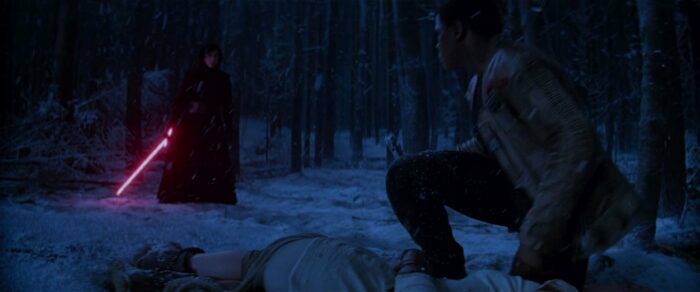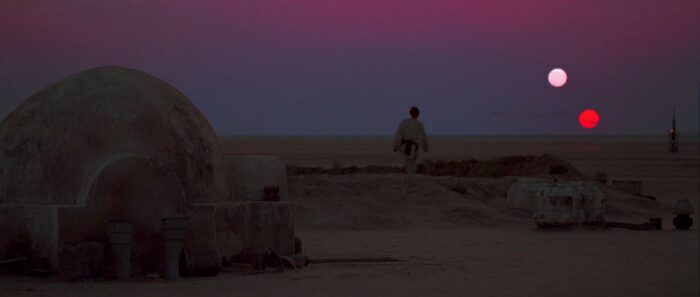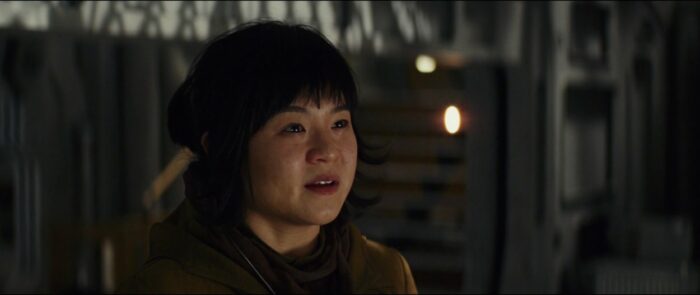Our heroes are running through a black forest, snow on the ground. They’re trying to get away from the monster chasing them, but it’s no use. There’s no way that they’d ever be able to outrun his anger. Instead, our heroes, a boy and a girl—young, brave, and devastated over the death of their mentor—turn to face their monster.
But the monster’s just a man, bleeding and furious and deeply miserable.
“It’s just us now,” he says. And he’s right. It is. They’re what matters to the universe at this moment.
The confrontation quickly descends into a duel: the boy is injured, and the girl wrecks the monster, finally leaving him bleeding in the snowy forest as the ground splits and the monster is left on the other side of the chasm, where he can no longer follow his worst impulses and hurt the girl and boy.

Eventually, the forest blows up, and our heroes fly away on spaceships because that’s what happens in Star Wars—space explosions, overblown emotions, and strange magics. It’s what makes these movies so much fun.
Why did I spend so much time describing the climax of 2015’s The Force Awakens (Episode VII)? Because “it’s just us now.” The fairytale setting wasn’t lost on me when I first saw the movie, but it’s that line that has stuck with me.
Let me explain.
The climax of The Empire Strikes Back (Episode V) occurs in much the same way, but it’s not in a forest, it takes place in a city in the clouds. And the climax of Attack of the Clones (Episode II) takes place in a gladiatorial arena. Functionally, though, the three blur into each other.

It’s all heightened. It’s all a fairytale.
Time and again in Star Wars we revisit the exact same plots—the evil Empire has built a Death Star (three times, and yes, The Force Awakens’ “Starkiller Base” is just a Death Star with a new lick of paint), a reluctant hero has to bravely return to save his friends (Han Solo saw a lot of himself in Finn for a reason), and mentors and fathers and father figures have to die again, and again, and again.
It’s repetitive, to be sure, but I’d prefer to describe it as iterative. The emphasis in the narrative changes with each version of the same story—the Death Star was the point in A New Hope, it was the thing to be defeated. By the time The Force Awakens rolls around, it’s almost a joke. The deaths of Qui-Gon Jinn in The Phantom Menace (Episode I), and Obi-Wan Kenobi in A New Hope serve the same function in that their deaths allow our heroes (Obi-Wan and Anakin, and later Luke) to take charge of their destiny, no longer in the shadow of their father figures.
Han’s death is the inverse of that—he doesn’t know it yet, but this is the point where Kylo Ren (Ben Solo, the erstwhile son of Han and Leia) breaks. He thinks the murder of his own father is going to set him free, but it only results in more emotional damage and even more anger.
We’ll be coming back to this idea a bit later.
So, if Star Wars is constantly repeating itself, and revisiting the same ideas over and over again, changing only incidental parts of it, why do we care about it?
Because that’s what mythology does.
Myths are repetitive across time and space because they don’t exist as bastions of originality but rather to teach us important lessons.
Now we have to talk about comparative mythology, I’m afraid.
It’s no secret that Star Wars director George Lucas was profoundly influenced by comparative mythologist and literature professor Joseph Campbell and his seminal work The Hero With A Thousand Faces (1949). In case you don’t know what that book contains, here’s a very brief summary of his argument, as provided by Campbell himself:
A hero ventures forth from the world of common day into a region of supernatural wonder: fabulous forces are there encountered and a decisive victory is won: the hero comes back from this mysterious adventure with the power to bestow boons on his fellow man.
That, according to Campbell, is a summary of every story ever told. It’s called the Hero’s Journey, or the Monomyth, and it’s true across time, space, and cultures.
It’s both right and deeply reductive, but that doesn’t matter.
The point is, it’s a perfect summary of every Star Wars movie ever made.
At the core of Campbell’s writings is the idea that myths are told in this way because everyone needs to be able to understand the deeper meaning of the myth. Each instance is designed to reveal a new truth about ourselves, to open ourselves up to the purity of our nature, and to transcend our mundane, difficult lives to the much-longed-for happy ending.
Campbell wrote that “the function of ritual and myth is to make possible, and then to facilitate, the jump—by analogy,” meaning that we tell ourselves these stories in order to understand something else. According to Campbell, “myth is but the penultimate,” with a state of pure, loving openness being the final goal of all good myth cycles.
Lucas has been explicit for decades about his passion for this idea, telling Bill Moyers in 1999 that mythology exists to “construct a context for the unknown,” and that he wrote Star Wars with that specifically in mind.
The links between Star Wars and the writings of Joseph Campbell are obvious, and they are well-trodden ground. Lucas has discussed the influence multiple times, often in great depth and with obvious passion, and Campbell himself described Star Wars as “myth”—the two became friends in the 1980s towards the end of Campbell’s life.
So, apart from the fact that these links exist, what can Campbell tell us about Star Wars?
I don’t mean in terms of plot. Let’s not think about The Rise of Skywalker, let’s set it aside. Instead, let’s consider the story already told.
The first line of dialogue in 2015’s The Force Awakens was “This will begin to make things right”. A gesture at significance if there ever was one.
But it begs the question—what is it that has gone wrong? What needs to be made right?
Campbell writes that in myth there is always some “symbolical deficiency” that the hero needs to rectify, and it’s this lack that causes the hero to embark on his adventure.

The lack at the heart of Star Wars, the one that Lucas attempted to explore in the much-maligned prequels, is expressed most profoundly in The Last Jedi (Episode VIII).
“The Force is not a power you have,” Luke tells Rey, “It’s the energy between all things—a tension, a balance that binds the universe together.”
In hindsight, it’s easy to see the story Lucas was trying to tell in the prequels: Anakin, a boy of pure compassion and love, torn between his instincts and the manipulations of both Palpatine and the Jedi, representing how our understanding of love can become easily clouded by pride and dogma.
This is the story that Star Wars is still invested in telling—how can we cast off these “mind-forg’d manacles,” as Blake would say, and learn to love each other fully and, more importantly, selflessly.
George Lucas is such a hippy.
This is why Star Wars is iterative. Each Episode, each trilogy of movies represents an attempt to feel that state. Sometimes, like Luke’s declaration in The Return of the Jedi (Episode VI) that “I am a Jedi, like my father before me,” characters manage to grasp that truth for a moment before it slips through their fingers. How romantic of them.
Yoda even articulates this total renunciation of the self way back in The Empire Strikes Back, telling Luke “luminous beings are we, not this crude matter.” It’s a beautiful sentiment, but one that these movies make clear require work.
That brings us back to Kylo Ren’s murder of Han Solo. It’s as though he recognizes the cycle he is caught in and sees that certain story beats need to repeat, but has failed to understand the deeper meaning behind the cycle. By the end of The Last Jedi, he remains unwilling to do the work necessary to truly transcend this cycle of violence. “Let the past die,” he tells Rey, in a neat summary of how he has clearly failed to see the deeper implications of his actions.
Fathers have to die, it’s true, but that doesn’t mean you need to continue down paths of all-consuming selfishness. There are other ways forward.
The truth is, Star Wars disguises this core devotion to compassion and love underneath space battles, weird space magics, and cool space laser swords. It’s a fairy tale written for boys who would never sit through “Beauty and the Beast” or “Rumplestiltskin” or “Jack and the Beanstalk” or any of the older stories that these movies are very clearly drawing upon.
These lessons are hard to learn because they’re not glamorous or filled with glory, and the universe’s problems will never be solved by blowing up the other side. It requires thought and openness of feeling, and that can be quite the tough sell without the right packaging.
Rose Tico encapsulates the true meaning of Star Wars: that heroism can come from anywhere, that love and compassion will always, always win (at least in-universe), and that “That’s how we win—not by fighting what we hate, but saving what we love.”

She learned in the space of a single movie what the universe has been trying to tell the Skywalker family for decades.
Star Wars is not full of complex characters or particularly original stories because that’s not its point.
The truth is that George Lucas read Joseph Campbell many decades ago and has been trying to articulate the value of myth in his storytelling ever since.
As Campbell says, myth is only “the penultimate,” it’s not our endgame. The true end only comes when you apply what you’ve learned in your own life, step out your front door, and open yourself to the world of possibilities like every hero who has come before you.
So what is it that Star Wars wants us to be open to? Love. Compassion. Understanding each other and finding a path forward that rejects violence and hatred, refusing to repeat the mistakes of those who came before us.
We’re not this crude matter, luminous beings are we.


